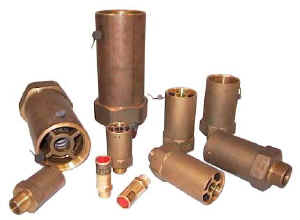|
SAFETY VALVES
SAFETY VALVES
SAFETY VALVES
|
REQUIREMENTS FOR PRESSURE SAFETY VALVES |
|
SAFETY VALVES
SAFETY VALVES
SAFETY VALVES
|
REQUIREMENTS FOR PRESSURE SAFETY VALVES |
OPERATION OF PRESSURE SAFETY VALVES |
|
Pressure safety valves are set and sealed by the manufacturer to function at a specific "start-to-discharge" pressure in accordance with regulations. This set pressure, marked on the safety valve, depends on the design requirement of the container to be protected by the relief valve. |
 |
If the
container pressure reaches the start-to-discharge pressure, the safety valve will open a
slight amount as the seat disc begins to move slightly away from the seat. If the pressure
continues to rise despite the initial discharge through the safety valve, the seat disc
will move to a full open position with a sudden "pop". This sharp popping sound
is from which the term "pop-action" is derived. |
|
 |
The re-seal pressure can be, and in most cases is, adversely affected by the presence of dirt, rust, scale or other foreign particles lodging between the seat and disc. They interfere with the proper mating of the seat and disc and the pressure in the container will usually have to decrease to a lower pressure before the spring force embeds foreign particles into the resilient seat disc material and seals leak-tight. The degree by which the presence of dirt decreases the re-seal pressure is, of course, dependent on the size of the interfering particles. |
Once particles have been trapped between the disc and seat, the start-to-discharge pressure is also affected. For example, the pressure relief valve will start-to-discharge at some pressure lower than its original start-to-discharge pressure. Again, the pressure at which the valve will start to discharge is dependent on the size of the foreign particles. |
In the case of a pressure safety valve that has opened very slightly due to a pressure beyond its start-to-discharge setting, the chances of foreign material lodging between the seat and disc is negligible although the possibility is always present. If the relief valve continues to leak at pressures below its start-to-discharge setting it must be replaced. |
 |